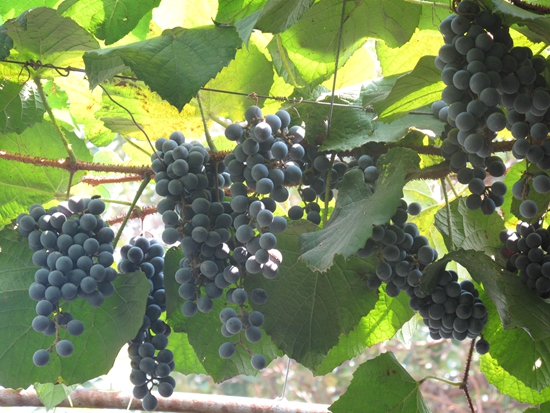分享到
New Research Progress in Chinese Grape Wild Relatives
Recently, Zhengzhou Fruit Research Institute (ZFRI) of CAAS announced periodical progress on the research of Chinese grape wild relatives (GWR). Their experts, in collaboration with University of Birmingham, Botany Institute of Chinese Academy of Sciences and China Agricultural University, have conducted research on GWR in China from all aspects of the ecogeographical diversity, conservation gaps and impact of climate change systematically. The research result was published online in Agriculture, Ecosystems and Environment on April 2, 2015.
According to Dr. Liu Chonghuai, head of the team at ZFRI, China is one of the major diversity center of grape (Vitis spp.) and of the most abundant sources of GWR, which represent a potentially important source of valuable traits for the improvement of cultivated grape varieties and have significant characters for resistance to biotic and abiotic stress factors. However, with the environment pollution and ecosystem degradation in recent years, many wild animals and plants are endangered or faced with extinction such as GWR. There has been no report on the number, geographical distribution and protected situation of GWR.

Figure1 V. davidii, one of GWRs, has large berries, and strong resistance

Figure 2 Geographical distribution of grape wild relatives in China
The research team studied the ecogeographic diversity of GWR, conservation gaps and impact of climate change on GWR in China, based on a wide range of distribution data sourced from germplasm and herbarium specimens, field surveys and other literature. Results show that there are 39 species, 1 subspecies and 14 varieties of GWR native to China and that 19 species and 9 varieties are the closest wild relatives to cultivated grape according to the Taxon Group Concept. GWR are distributed all over China except for Xinjiang. It is particularly abundant in Jiangxi and Hunan Provinces. The richest regions for GWR are in the Qinling, Daba, Wuling, Nanling and Wuyi mountains. Around 22% of GWR species are found in natural reserves (NRs) and are well protected, but 15 species are not found in NRs and require further strengthening of both protection and collection.
The potential distribution of GWR at the present and predicted future climate are compared using BIOCLIM. The results showed that simulated current distributions matched actual distribution ranges. Under the future climate scenario with doubled CO2 concentration, suitable areas for continued survival of 21 GWR could be reduced. The research results will be highly valuable for the development of a complementary conservation strategy for GWR.
More details are available online at:
http://www.sciencedirect.com/science/article/pii/S016788091500105X
According to Dr. Liu Chonghuai, head of the team at ZFRI, China is one of the major diversity center of grape (Vitis spp.) and of the most abundant sources of GWR, which represent a potentially important source of valuable traits for the improvement of cultivated grape varieties and have significant characters for resistance to biotic and abiotic stress factors. However, with the environment pollution and ecosystem degradation in recent years, many wild animals and plants are endangered or faced with extinction such as GWR. There has been no report on the number, geographical distribution and protected situation of GWR.

Figure1 V. davidii, one of GWRs, has large berries, and strong resistance

Figure 2 Geographical distribution of grape wild relatives in China
The potential distribution of GWR at the present and predicted future climate are compared using BIOCLIM. The results showed that simulated current distributions matched actual distribution ranges. Under the future climate scenario with doubled CO2 concentration, suitable areas for continued survival of 21 GWR could be reduced. The research results will be highly valuable for the development of a complementary conservation strategy for GWR.
More details are available online at:
http://www.sciencedirect.com/science/article/pii/S016788091500105X
By Jiang Jianfu
jiangjianfu@caas.cn
jiangjianfu@caas.cn
Latest News
-
 Apr 18, 2024Opening Ceremony of the Training Workshop on Wheat Head Scab Resistance Breeding and Pest Control in Africa Held in CAAS
Apr 18, 2024Opening Ceremony of the Training Workshop on Wheat Head Scab Resistance Breeding and Pest Control in Africa Held in CAAS -
 Apr 03, 2024IPPCAAS Co-organized the Training Workshop on Management and Application of Biopesticides in Nepal
Apr 03, 2024IPPCAAS Co-organized the Training Workshop on Management and Application of Biopesticides in Nepal -
 Mar 28, 2024Delegation from the School of Agriculture and Food Science of University College Dublin, Ireland Visit to IAS, CAAS
Mar 28, 2024Delegation from the School of Agriculture and Food Science of University College Dublin, Ireland Visit to IAS, CAAS -
 Mar 25, 2024Director of World Food Prize Foundation visited GSCAAS
Mar 25, 2024Director of World Food Prize Foundation visited GSCAAS -
 Mar 20, 2024Institute of Crop Sciences (ICS) and Syngenta Group Global Seeds Advance Collaborative Research in the Seed Industry
Mar 20, 2024Institute of Crop Sciences (ICS) and Syngenta Group Global Seeds Advance Collaborative Research in the Seed Industry
